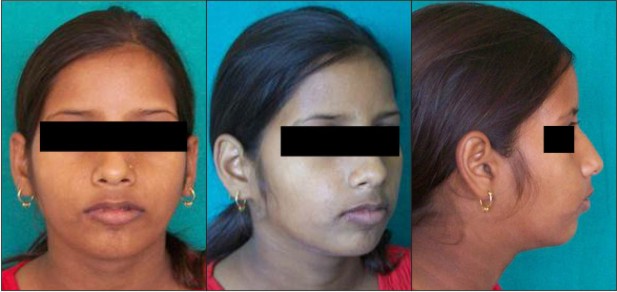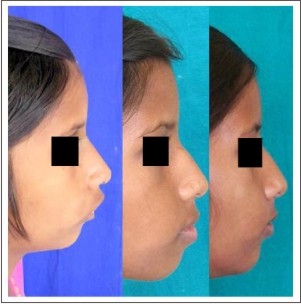Introduction
The twin-block appliance, described by Clark is currently the most popular functionalappliance all over the world. Recentevidence suggests that it may also be considered the most successful in the treatment of skeletal Class II malocclusions in growing patients. Twin Block appliances are designed and adjusted to control molar eruption, and the posterior open bite is progressively reduced during Twin Block treatment. After the active phase, an anterior inclined plane is used to support the corrected occlusion while the buccal teeth erupt into full occlusion. The control of vertical dimension by encouraging selective eruption of posterior teeth is crucial in all functional treatment if appliances with occlusal inclined planes are correctly designed, the Twin Block technique has been shown to have a wide application in dentofacial orthopedic correction.[1],[2],[3],[4]
Patient Selection and Bite Registration
Patients who may be considered for this modified Twin Block technique are those with a Class II division I incisor relationship on a Class II skeletal base with an ANB of 6–10 degrees and ahyperdivegent mandibular plane. The bite registration is taken with the buccal segment relationship in an over corrected position, this may result in an edge-to-edge incisor position or a slight reversed overjet. However, by ensuring that there is 7–8 mm of separation in the buccal segments, there should be no incisal interference as the upper labial segment is proclined. It is important to have more height of the blocks to ensure it compensates for the eruption of molars which is not desirable in hyperdivergent patients.[5],[6],[7]
Appliance Design
The mentioned applianceis a modification of the Clark Twin Block (Clark, 1982). They have maxillary block held together only by a modified transpalatal arch and there is palatal coverage with acrylic resin and the mandibular blocks were held by a modified lingual arch. The inclined planes are constructed at 70 degrees to the occlusal plane. The additional modificationwas the bite was higher than the normal twin block as it was necessary for vertical growing patients.[7],[8],[9],[10],[11]
Case Report
A 12 year-old female presented with a Class I molars on a Class II skeletal base, with mandibular retrognathia. All permanent teeth were present There was mild crowding in the labial segments. In occlusion the overbite was 5 mm and, complete, the overjet was 9 mm. The buccal segment relationship was a full unit Class II bilaterally. The cephalometric tracing confirmed that the patient had a Class II skeletal base relationship with an ANB value of 10 degrees; the mandibular planes angle was 41 degrees. The upper incisors were at 8mm/31 degrees , with the lower incisors at 9/32degrees. The inter-incisal angle was 108 degrees. (Fig 1,2) Treatment involved correcting the Class II skeletal relationship with a Twin Block appliance Modified Fixed Twin Block appliances were cemeneted and instructions were given for its care.
Antero-posterior correction of the buccal segments was achieved after 10 months full time wear, at this stage we removed the twin blocks and decided to go in for upper second premolar and lower first premolar extraction for the correction of the incisor inclinations and molar relations.T
In occlusion there were substantial lateral open bites and minimal functional occlusal contacts.(Fig 3,4)
 | Fig 1 : Pre Treatment Extra Oral Photograps
 |
 | Fig 2 : Pre Treatment Intraoral Photographs
 |
 | Fig 3 : Post Twin Block Intra Oral Photographs
 |
 | Fig 4 : Post Twin Block Extra Oral Photographs
 |
 | Fig 5 : Fixed Appliance Intra Oral Photographs
 |
 | Fig 6 : Post Treatment Extra Oral Photograph
 |
 | Fig 7 : Post Treatment Intra Oral Photograph
 |
 | Fig 8 : Profile Photograph
 |
The patient was now bonded the MBT .022 fixed appliance.During the transition into fixed appliances an inclined clip over bite plane was worn full time, until upper and lower 0.019 × 0.025-inch stainless steel archwires were in place and correction of the lateral open bites by buccal segment eruption was achieved. A fully bonded pre-adjusted Edgewise appliance was fitted to produce a mutually protected functional occlusion. (Fig 5) Total treatment time was 26 months. Pre-debondcephalo metric analysis revealed correction of the upper incisor inclination to 4mm/17 degrees, the lowers to 5.5mm/28 degrees. The reduction in the ANB had improved to 5 degrees mainly by an increase in SNB. SNA remained at its post-functional value.The case was debonded and retention with reverse inclined plane was given. (Fig 6,7,8)
References
1. W.J. Clark,The Twin Block technique. A functional orthopaedic appliance system,Am. J. Orthod. Dentofac. Orthop., 93 (1) (1988), pp. 1–18
2. L. Hichens, H. Rowland, A. Williams, E. Hollinghurst, P. Ewings, S. Clark, A. Ireland, J. Sandy,Cost-effectiveness and patient satisfaction: Hawley and vacuum-formed retainers,Eur. J. Orthod., 29 (2007), pp. 372–378
3. W.J.B. Houston, C.D. Stephens, W.J. Tulley,A textbook of orthodontics,Wright, Oxford (1992)
4. R.T. Lee, C.S. Kyi, G.J. Mack,A controlled clinical trial of the effects of the Twin Block and Dynamax appliances on the hard and soft tissues,Eur. J. Ortho., 29 (3) (2007), pp. 272–282
5. D.I. Lund, P.J. Sandler,The effect of Twin Blocks: a prospective controlled study,Am. J. Orthod. Dentofac. Orthop., 113 (1998), pp. 104–110
6. C.M. Mills, K. McCulloch,Treatment effects of the twinblock appliance: a cephalometricstudy,Am. J. Orthod. Dentofac. Orthop., 118 (1998), pp. 24–33
7. J.R. Mills,The effect of functional appliances on the skeletal pattern,Br. J. Orthod., 18 (4) (1991), pp. 267–275
8. O’Brien et al.,The effectiveness of treatment of class II malocclusion with the Twin Block appliance: a randomised, controlled trial,Am. J. Orthod. Dentofac. Orthop., 124 (2003), pp. 128–137
9. O’Brien et al.,The effectiveness of treatment of class II malocclusion with the Twin Block appliance. A randomised, controlled trial. Part 1: dental and skeletal effects,Am. J. Orthod. Dentofac. Orthop., 124 (2003), pp. 234–243
10. O’Brien etal.The effectiveness of treatment of class II malocclusion with the Twin Block appliance: a randomised, controlled trial. Part 2: psychological effects,Am. J. Orthod. Dentofac. Orthop., 124 (2003), pp. 488–495
11. H. Rowland, L. Hichens, A. Williams, D. Hills, N. Killingback, P. Ewings, S. Clark, A. Ireland, J. Sandy,The effectiveness of Hawley and vacuum-formed retainers: a single centre randomized controlled trial,Am. J. Dentofac. Orthop., 132 (2007), pp. 730–737
|